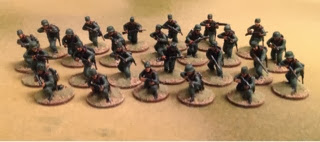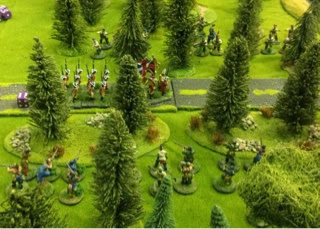The WW2 Far East project is back on track with some more reading on the Malayan campaign.
This time a compelling story about the 'stay behind' units and one Freddy Spencer Chapman. He spent over three years behind Japanese lines, mostly with Chinese communist guerillas. All the more remarkable given that he was more famous pre-war for his expeditions in the Arctic.
Brian Moynahan has written a gripping narrative of his story, 'Jungle Soldier'. He draws heavily on Chapman's own account in, 'The Jungle is Neutral' (1949). It was only half way through Moynahan's book that I remembered that I had a second hand copy of this tome in my reading pile.
Not a wasted purchase because Chapman wrote his account during the Malayan Emergency and therefore missed out some important details. Also frankly, Moynahan is the better writer and gives a wider perspective. I won't summarise the story because that would ruin what is an excellent read and a credit to a remarkable story of endurance.
One of the more interesting points for me is hinted at in the title of the book. The Japanese were far from being the expert jungle fighters they were portrayed as being at the time. Chapman shows how their jungle craft was limited and had the stay behind parties been better equipped and supported, could have done even more damage.
More progress on the figure front as well. These are the first of the 28mm Malayan project using Bolt Action. Perry 8th Army plastics work well for this project because several units earmarked for the desert were sent to Singapore. The issue of tropical uniforms convinced the troops that the desert was the destination. After arriving only to be captured by the Japanese, most would have wished the original plan had held up!
Welcome to my blog!
News from a wargamer with a special interest in the military history of the Balkans. It mainly covers my current reading and wargaming projects. For more detail you can visit the web sites I edit - Balkan Military History and Glasgow & District Wargaming Society. Or follow me on Twitter @Balkan_Dave
or on Mastodon @balkandave@mastodon.scot, or Threads @davewatson1683
or on Mastodon @balkandave@mastodon.scot, or Threads @davewatson1683
Friday, 15 November 2013
Tuesday, 12 November 2013
China's War with Japan
My Far East project has taken a bit of a detour into the Sino-Japanese conflict, which of course began before WW2. My latest reading is Rana Mitter's 'China's War with Japan', a book I discovered through a History Magazine Extra podcast. I can recommend these if you haven't tried them yet.
China's contribution to the defeat of Japan in WW2 is probably not fully appreciated, at least in the West. China continued fighting for eight years when it could have surrendered. They tied down half a million Japanese troops that could have been deployed elsewhere in the Pacific, most notably in an invasion of India. China paid a heavy price, with some 14 to 20 million dead.
This is a broad narrative history that takes us from the, almost accidental, outbreak of war in 1937 to the unexpected capitulation in 1945. It is a complex tale that focuses on the political history of the period because in practice there were three China's at play. The Nationalists, communists and the collaborationist governments. The outside actors, most notably the Americans and Russians, play an important role as well.
The military historian will be frustrated by the way the author brushes over the detail of major campaigns. However, the political context is important here, more so than many other campaigns, so this is definitely required reading.
Monday, 4 November 2013
Handschar in 28mm
The latest additions to my Bolt Action 28mm Balkan WW2 project are the Handschar. Or properly, the 13th Waffen Mountain Division of the SS Handschar (1st Croatian).
This was a Waffen SS unit recruited mostly from Bosnian Muslims. They joined up primarily to secure their communities from the depredations of the Croatian Ustashi. By 1943 over 100,000 Bosnian Muslims had been killed and 250,000 had become refugees. Himmler had a somewhat romantic view of Islam and the fighting reputation of Bosnians, based on their record in WW1. The Bosnians had a generally positive view of the Austro-Hungarian Empire, which meant they were inclined to welcome the Germans.
They spent most of the war fighting Tito's partisans in a series of operations that had limited success. As the Russians poured through the Balkans they mostly drifted home. Those who stayed to the bitter end either died in action or were executed for war crimes. Not a happy story, but they are an important and distinctive unit in partisan warfare of the period.
The models are Warlord Germans with Handschar heads that be bought separately. There are plenty of pictures of these troops in George Lepre's 1997 book, 'Himmler's Bosnian Division: The Waffen-SS Handschar Division 1943–1945'. Plus the Osprey titles on the period.
Sunday, 3 November 2013
Muskets and Tomahawks
I played my first game of Muskets and Tomahawks today at the club. A dry run for the club display game at the Targe show next weekend at Kirriemuir.
For those not familiar with these rules they are for skirmish games in the French Indian Wars or the AWI period. Each side has a number of small 6 to 10 figure units with officers that are useful for morale purposes. Activation is by cards for different types of unit together with event cards that add the unexpected, without dominating the game. Shooting and combat is a simple D6 system and the rules are quickly picked up after a couple of turns.
While I have no intention of returning to this period, I can see an option to use them on the Military Border in Croatia during the 18th Century. The small war skirmishing was very similar with irregulars supported by regular troops based in the main garrisons. It will probably need different cards but otherwise looks like an interesting option.
Here are a few photies of the game today as a taster for those attending Targe. Sadly not me as work intervenes.
Subscribe to:
Posts (Atom)






